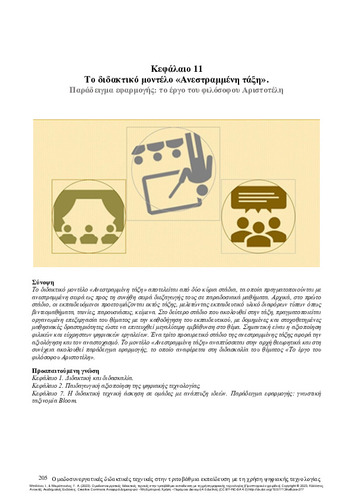| Title Details: | |
|
The “Flipped Classroom” instructional model. Example: the work of the philosopher Aristotle |
|
| Authors: |
Bellou, Ioanna Mikropoulos, Anastasios |
| Description: | |
| Abstract: |
The Flipped Classroom instructional model consists of two main stages, which are carried out in the reverse order of their usual order in traditional courses. Initially, in the first stage, learners prepare outside the classroom, studying educational materials of various types such as video lessons, films, presentations, texts. In the second stage that follows in the classroom, the subject is worked on in an organized manner under the guidance of the teacher, with structured and targeted learning activities in order to achieve greater depth in the subject. The use of friendly and easy-to-use digital tools is important. A third optional stage of the flipped classroom involves evaluation and reflection. The "Inverted Classroom" model is first developed theoretically and then followed by an example of application, which refers to the teaching of the topic "The work of the philosopher Aristotle".
|
| Linguistic Editors: |
Pitsoli, Kalliopi |
| Graphic Editors: |
Skouloudis, George |
| Type: |
Chapter |
| Creation Date: | 07-07-2023 |
| Item Details: | |
| License: |
Attribution - NonCommercial - ShareAlike 4.0 International (CC BY-NC-SA 4.0) |
| Handle | http://hdl.handle.net/11419/9997 |
| Bibliographic Reference: | Bellou, I., & Mikropoulos, A. (2023). The “Flipped Classroom” instructional model. Example: the work of the philosopher Aristotle [Chapter]. In Bellou, I., & Mikropoulos, A. 2023. Group and collaborative instructional techniques in tertiary education with the use of digital technology [Undergraduate textbook]. Kallipos, Open Academic Editions. https://hdl.handle.net/11419/9997 |
| Language: |
Greek |
| Is Part of: |
Group and collaborative instructional techniques in tertiary education with the use of digital technology |
| Publication Origin: |
Kallipos, Open Academic Editions |

